Final Fantasy VII Remake (PlayStation 4) Review
By Renan Fontes  17.04.2020
17.04.2020
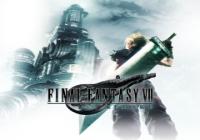
Few remakes in video game history have been as eagerly anticipated as Final Fantasy VII's has. Despite being a masterclass in game design that only shows its age superficially, the medium's rapid technological growth coupled with a now legendary tech demo for the PS3, lit a fire that would not go out until Square Enix remade what is arguably the strongest RPG in their gameography. 23 years have come and gone, since the original's release, and the medium has fundamentally changed since. For better or worse, Final Fantasy VII Remake is finally here - not as a reflection of the classic fans have been yearning for, but a deep reimagining that's more VII-2 than it is VIIR.
Announced alongside the reveal of Final Fantasy VII: Advent Children in 2003, Square Enix's Compilation of Final Fantasy VII was a meta-series meant to expand the world, themes, and characters of the eponymous RPG. Composed of one film and three games of varying quality, the Compilation came to a quiet end in 2007, with the release of Crisis Core: Final Fantasy VII. Square Enix affirms the Compilation was always meant to be solely comprised of these titles in an attempt to avoid market saturation, but the fact of the matter is that the Compilation was a poor idea by design. Final Fantasy VII is a fairly open and shut story, where all the core arcs have come to a definitive, thematically satisfying close by the time the credits roll. At the same time, the Compilation's legacy has always existed beside its source game.
Crisis Core and Dirge of Cerberus are poor thematic and narrative follow-ups to FFVII, but they're also inoffensive, easy to ignore, and charming in their own right. The original Final Fantasy VII is a strong enough RPG where there's no reason to even think of the Compilation while playing it. More importantly, the Compilation was never trying to match the legendary quality of its namesake (with the exception of the ambitious to a fault Advent Children), simply delivering sensible amounts of fan service by giving the Turks, Zack, and Vincent their own games. As a result, it's easier to overlook the flaws in a prequel like Crisis Core than a full blown remake. Narratively, it's hard to ignore just how often Final Fantasy VII Remake invokes the tone, theming, and general plotting of the Compilation. This isn't Square Enix pulling the rug under everyone's feet, demanding the audience dive into the Compilation to fully understand the remake. Rather, it's an attempt at repurposing those elements unique to the meta-series into the story proper.
Aesthetically, while there's far more colour than in the Compilation across the board, the remake is very similar in tone to Advent Children, particularly when it comes to action. Cloud and the party are basically operating with Dissidia-level mobility. The over the top cinematography is actually quite entertaining most of the time, but it's hard not to draw unpleasant comparisons at its worst. The Whispers, brand new characters who serve as arbiters of fate, are such a terrible concept, they'd fit right in with Angeal and Genesis. Whispers exist to prevent the main characters from straying off the main story, ensuring the remake plays out like the original. It's a layer of meta-commentary that only gets worse and worse as the story goes on, distracting from a plot that's actually gripping.
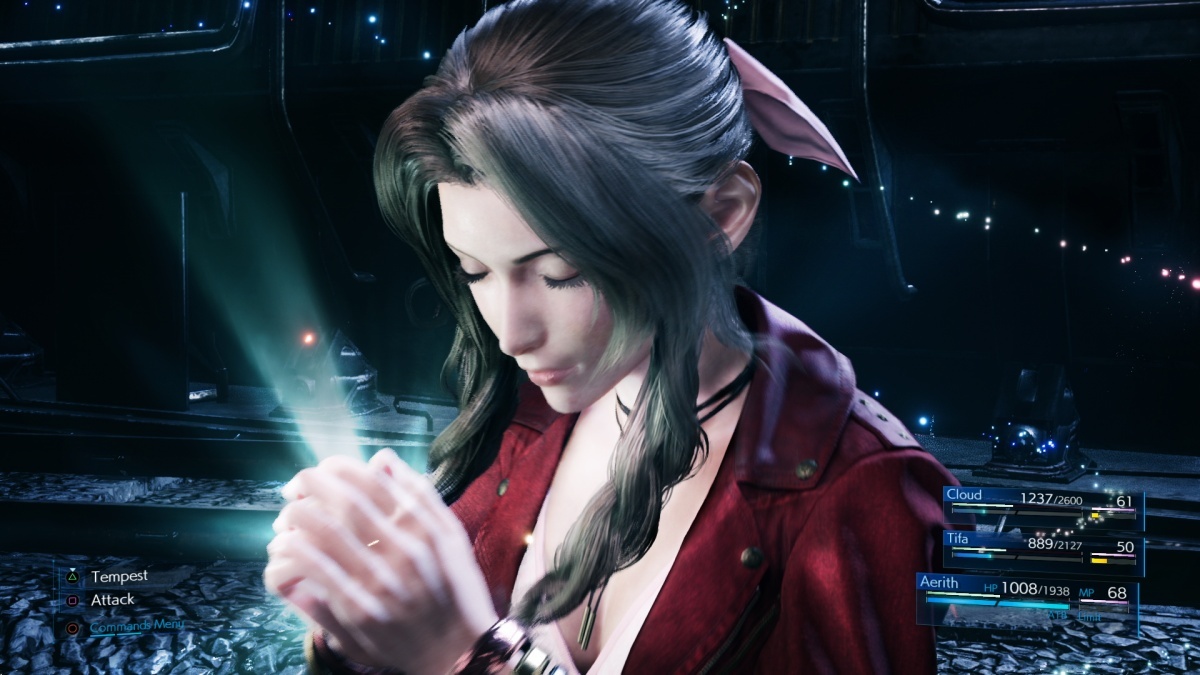
The most notable and immediate link to the Compilation has to be the intimate inclusion of Sephiroth. In the original release, Sephiroth was an antagonist whose reveal was very carefully built up within the story. Sephiroth was an unseen entity with only offhand references to flesh out his personality. The build-up makes Sephiroth's formal introduction into the story all the more impactful - a narrative game changer if there ever was one. This time around, Sephiroth is present more or less from the get-go - terrorizing and taunting Cloud through visions periodically. On one hand, it does make sense to flesh out the main villain, especially because the remake is episodic (more on that later.) On the other hand, the remake does not flesh out Sephiroth whatsoever, making use of the iconography of Sephiroth without any of the character. Sephiroth very quickly becomes a distraction. All of his appearances bring the story to a halt, taking up a distracting amount of space in a plot that does not need interruptions; which is another fault of the remake worth noting.
The original is one of the best paced RPGs in Square Enix's library, seamlessly jumping from beat to beat, dungeon to dungeon, with more set pieces than the average player will remember by the time they beat the game. The remake fails to meet the original on every level when it comes to pace. This is a slow, methodical reimagining of Midgar, and that's not necessarily a good thing. In fleshing out what is essentially six hours of gameplay, this needs to make use of a lot of new material to keep everything moving seamlessly from start to end. New material doesn't always translate to good material, though. Expanding on the Mako Reactors and Wall Market end up being excellent changes that put into perspective the sheer scope of Midgar, and what Avalanche is attempting to do. Padding out the sewers and Train Graveyard, not so much. If nothing else, moments of filler are used to capitalize on the characters - arguably the strongest aspect of the script. Cloud in particular is the best he's been written since the original Final Fantasy VII.
The Compilation had a nasty habit of often forgetting that Cloud did indeed have a personality, but the remake embraces all sides of Cloud in earnest. He's charming, dorky, funny, rude, and a genuine badass. While the fact the remake doesn't tell a full story does mean Cloud doesn't have a substantial character arc, he does gradually develop over the course of the game. Cloud's relationships with the supporting cast are handled spectacularly as well. His chemistry with Jessie, Tifa, and Aerith all show different sides to his character - from his many shades of indifference, to how he expresses affection. Barret slowly coming to respect Cloud, and Cloud giving that respect back in turn, makes for a compelling arc when fleshed out. It's really no different than their relationship in the main game, but the characters admittedly come out the remake benefitted from all the extra screen time in Midgar.
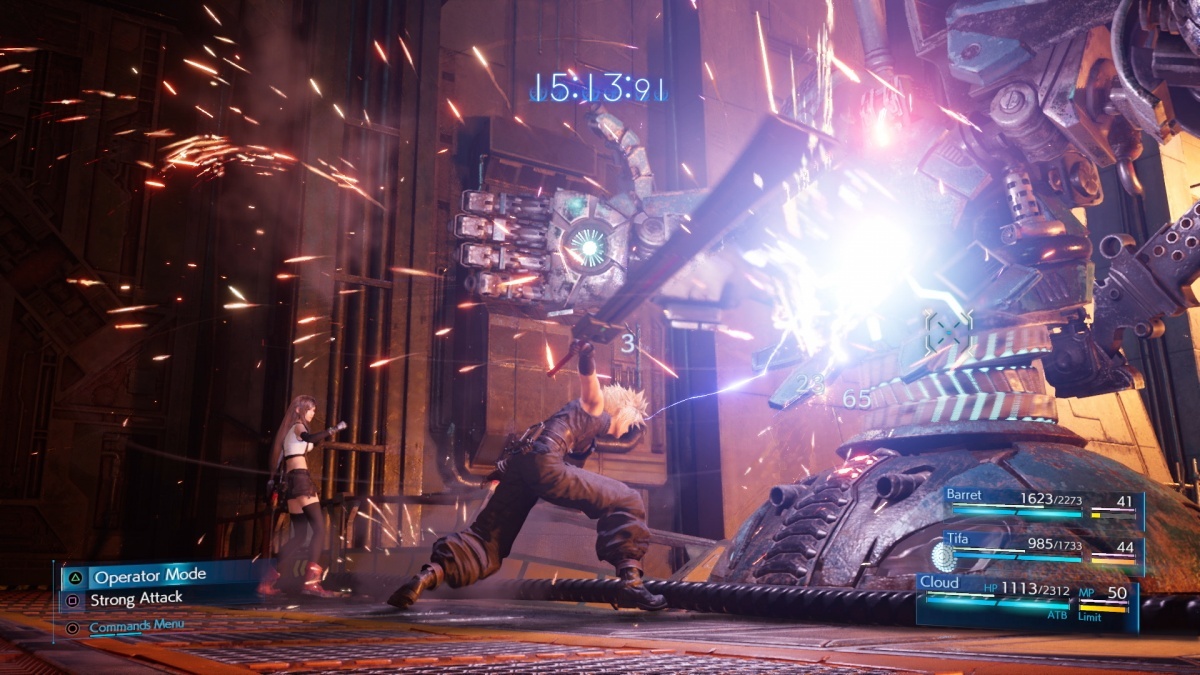
It isn't as if the remake has nothing to say with fleshing out Midgar so extensively, either. While the overall pacing is a let-down, there are isolated moments of brilliance scattered throughout the plot. Like all modern mainline entries in the franchise, Final Fantasy VII Remake divides itself into chapters - 18 to be exact. For reference, Chapter 1 covers the introductory bombing of Mako Reactor 1, and Chapter 18 ends right before the main cast sets off for Kalm (essentially a quarter of the way through disc 1 out of 3.) At roughly 30 hours per play-through, that's quite a while to spend in Midgar, but the city comes off far realer. The slums have a favela-like quality that captures a worst case scenario for the lower class. While the art direction isn't nearly as vibrant as the original's, opting instead for a tinge of realism, there is an appreciable quality to Midgar's grounded aesthetic. It isn't as if the city is devoid of colour either, as Wall Market does more than enough to capitalize on the original game's inherent style. Dancing mini-games, a dash of non-linearity, and plenty to explore, if the entire remake were like Wall Market, fans would have nothing to worry about.
While the segmented nature of the story means the party is never in one place for long, areas which allow the player to walk around and observe their surroundings tend to be filled with plenty of little details. NPC dialogue is more than just mindless banter, often helping flesh out Midgar even further, or just putting into perspective the mindset of the average Midgar citizen. It's important to remember that while Avalanche has good intentions, they're a terrorist organization that Shinra uses aggressive propaganda against. The average Midgar citizen fears Avalanche because they're the ones dealing with the consequences of the organization's bombings. Watching innocent civilians flee in terror as a collapsing Reactor threatens to kill them makes for a poignant moment. Aerith making her way through an apocalyptic Sector 7 and Tifa reminding a self-righteous Barret that people fear, Avalanche help the audience come away with a better understanding of Midgar's culture.
Unfortunately, as nice as Midgar looks in practice, the level design is a huge disappointment. The original Final Fantasy VII has some of the best dungeon design in the franchise, something the remake does not replicate. Instead, Midgar is filled with hallway after hallway - a criticism of the series that's been tired since Final Fantasy XIII, but one that still rings all too true. At its best, the remake's dungeons never go beyond just good, opting for an extreme amount of linearity with only a few secret paths littered throughout. If there's any area where the remake fails conclusively, it's here. Midgar just isn't fun to explore half the time. Slowly shuffling through alleyways has never been a fun way to approach traversal, and while the visuals are also pretty, there's something hollow about following a map to the objective with nothing along the way worth finding half the time. Mini games are occasionally used as a means to spice up exploration, but they're often slow-paced, stiff to control, and completely charmless. The only mini games that stand out as tolerable are the few in Wall Market.
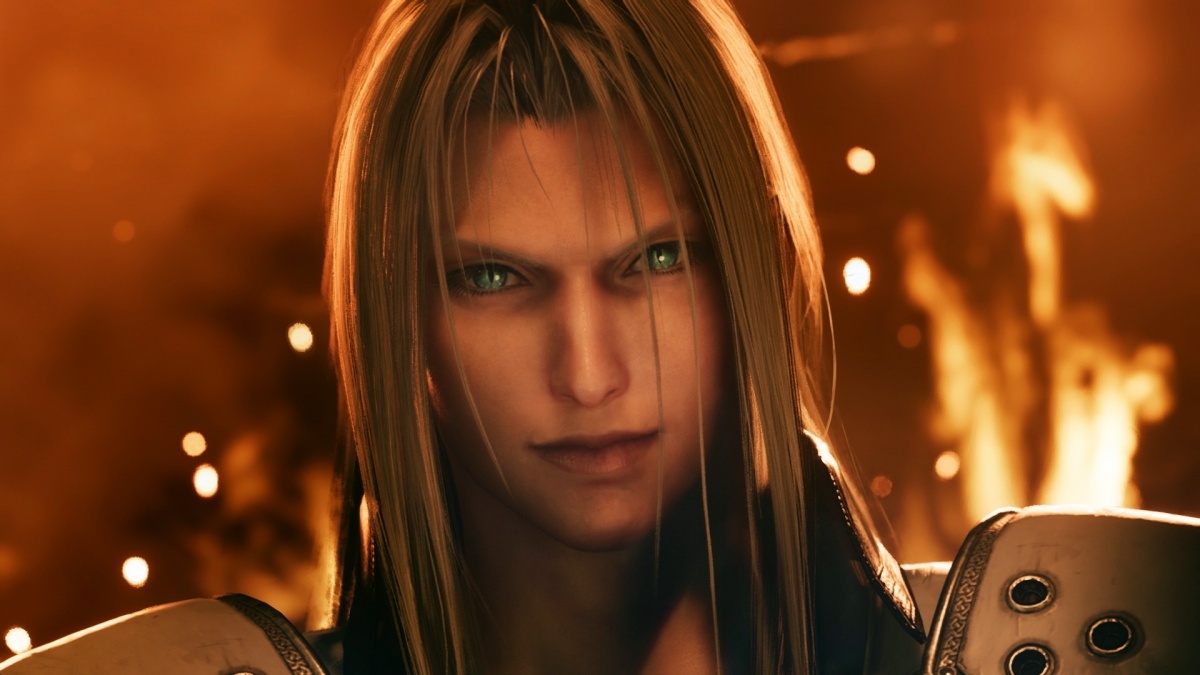
Not helping matters are the mediocre side quests. They do get better over the course of the game, shockingly, but the quests present in Chapters 3, 8, and 9 are little more than chores. The average quest is no better than the average MMO mission. If nothing else, the character banter that comes from actually completing side quests does make most of them worth it. It's just a shame Midgar is such a bore to actually traverse. The remake actually allows the player to explore a huge chunk of the map in Chapter 14, and it's almost laughable how small the world is - but hey, that's what happens when remaking six hours of a full length RPG. Perhaps the worst part about Midgar is how underpopulated it is. Not in terms of NPCs (Square Enix actually did a superb job at making Midgar feel like a lived-in world), but enemies.
Typical of the genre at the time, Final Fantasy VII made use of random battles on the PS1. While random battles are easy to dismiss as a gameplay fixture dictated by hardware limitations, they serve the incredibly important purpose of maintaining an uncluttered sense of setting while keeping the player busy. When it comes down to it, random battles are just more gameplay. The combat is the heart of an RPG, and random battles allow the gameplay loop to keep the action consistent. In keeping its world visually clean and easy to traverse, the remake's Midgar is severely lacking in enemies to fight. What few monsters there are roaming the overworld tend to be incredibly similar in type, and respawn so infrequently, there's no reason any sane players should try levelling off them.
It's especially a pity because the core combat is leagues above the rest of the experience in quality. The remake ditches the original's trademark turn based combat in favour of something more akin to action-RPGs. Cloud can indefinitely attack enemies with Square, pulling off actual combos in the process. Circle even allows him to dodge, and R1 is a traditional block. That said, the only way to use Items, Abilities, Spells, or Summons is through the ATB. This gauge will slowly increase throughout the course of battle, but attacking and blocking enemies help fill it faster. Once a charge on the Gauge has been filled (each party member having a minimum of two), players can then access their Command Menu. While opening the menu doesn't stop combat, it does slow it considerably, allowing one to plan out their next move at their leisure. For those that don't want to break the flow of combat, however, it's possible to map commands to shortcuts with L1. By pairing L1 with the four face buttons, each party member can have access to four shortcut commands at any given time. Alongside Cloud, Barret, Tifa, and Aerith round off the party, each one having their own unique play style.
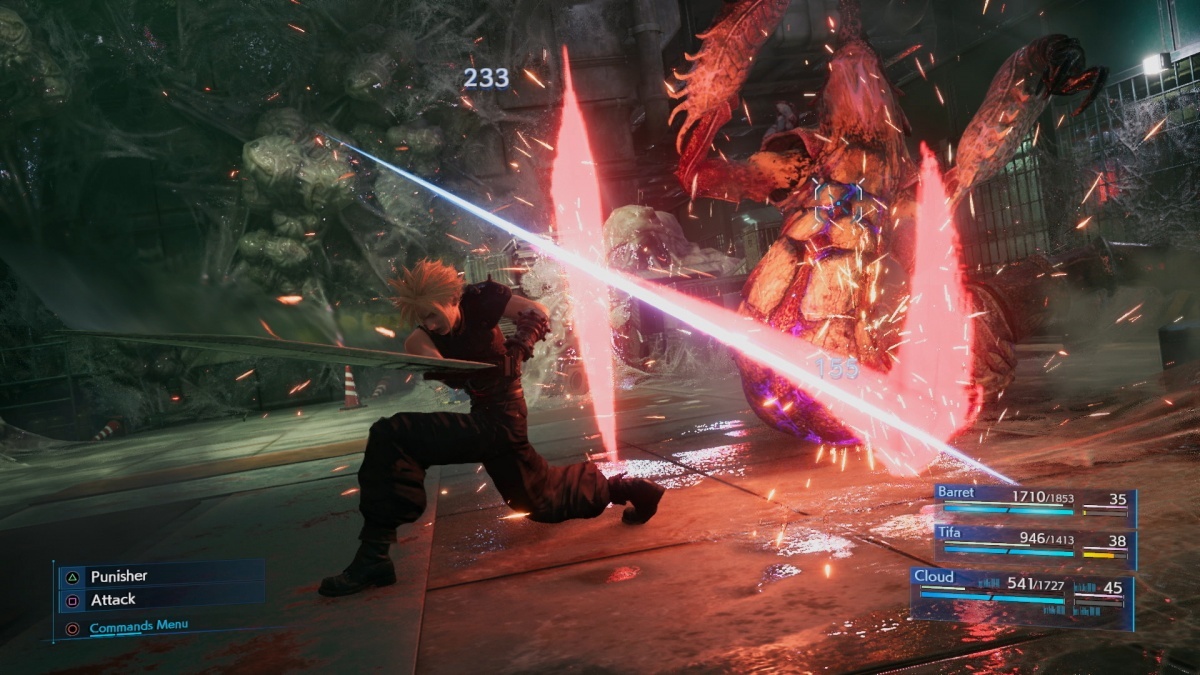
Perhaps as expected, Cloud stands out as the most balanced member of the party. He's strong all around, fast, can take a decent amount of damage, and has two distinct play styles. Each character has access to a personal ability that can be triggered at any point during combat without the need for ATB charges. Cloud in particular has access to Mode Change. By pressing Triangle, Cloud will swap between his Punisher and Operator. Operator is Cloud's default mode, and the one he begins every battle in. Modeled after Sephiroth's nimble swordsmanship, Operator Mode prioritizes chaining quick combos, and allows Cloud to dodge in and out of action while being able to block long-range or magical attacks. By holding down Square in Operator Mode, Cloud will do a heavy attack, which will briefly self-cast Berserk, buffing his offense at the expense of his defence.
Although players can press Triangle to have Cloud swap into Punisher Mode at any time, pressing Triangle right as an enemy attacks will result in Cloud doing a heavy hitting counter attack - one of Punisher Mode's specialities. Although much slower than Operator Mode, Punisher Mode hits obscenely hard and fills the ATB Gauge even faster. Styled after Zack Fair's powerful swordplay, Punisher Mode makes one-on-one boss fights a blast. By pressing R1 at just the right time, Cloud will counter enemy attacks, creating openings. By swapping in and out of Punisher with a Triangle counter, it's possible to pull off some truly impressive feats in battle, especially thanks to the other ability system.
Along with character abilities, there are weapon abilities to learn. Each weapon has its own unique skill that, once used enough times in battle, it can then be used regardless if a player has that specific weapon equipped. Weapon abilities not only encourage players to routinely go through new weapons, they help round out the combat even more. Unlike magic, weapon abilities don't consume MP, and they're often just as useful as Spells. With abilities like Triple Slash, which sees Cloud strike three enemies back to back to back in rapid succession, and Disorder, whipping Cloud out of whatever mode he's in with a heavy strike, it's not hard to craft a satisfying frantic skill set for the Ex-SOLDIER.
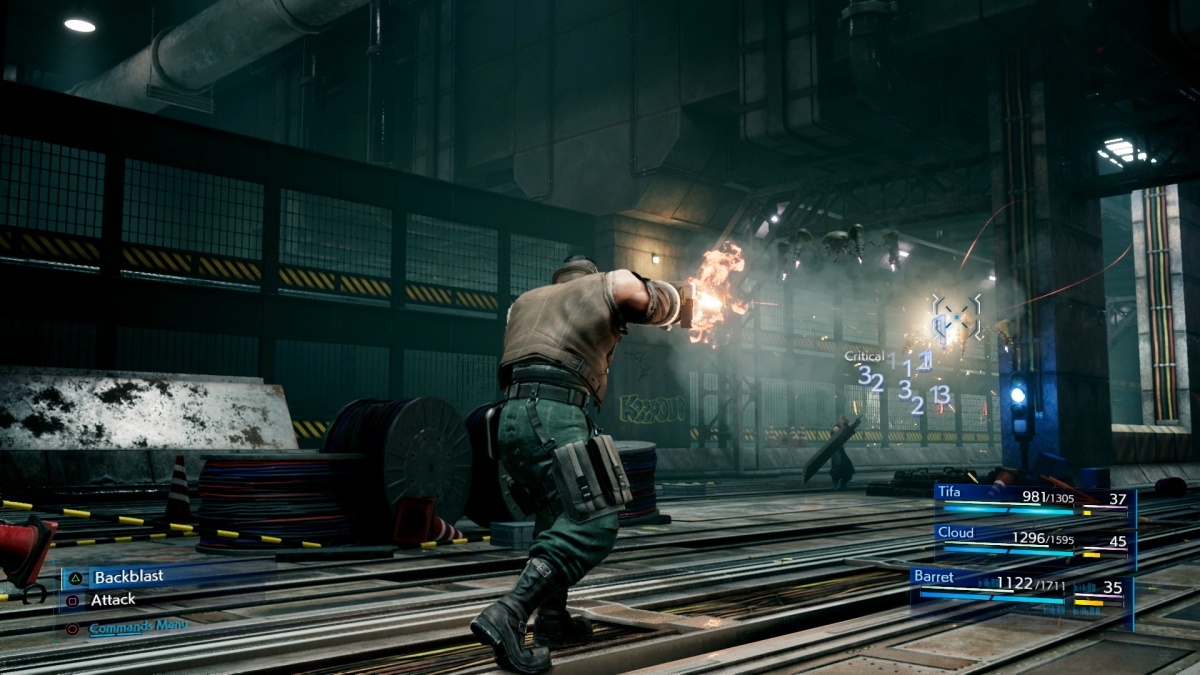
True to form, Barret is the remake's second playable character. With a machine gun attached to his arm, Barret can fire at enemies from long range, filling both his ATB Gauge and a personal ability gauge. Depending on which arm Barret has equipped, his ability can range from a focused shot from far away, or a close range bash into his foes. While Barret's skill set prioritizes long range, he's a tank who can take just as much damage as he can deal it. Tifa gives the player a full party of three once they head to Mako Reactor 5, and she's a highlight of the battle system. As strong as she is fast, Tifa prioritizes close range combat above all else. Her personal ability seems to be a simple uppercut at first glance, but through the use of Unbridled Strength - Tifa's real personal ability - she'll increase her chi, buffing her stats and upgrading the Whirling Uppercut to the Omnistrike. By stacking another Unbridled Strike, Tifa can further buff Omnistrike to Rise and Fall. From there, each ability can be used in rapid succession, making Tifa quite the monster killer.
Like Cloud, Tifa's weapon abilities offer her a great deal of mobility in battle. Unlike Cloud who struggles with aerial combat, Tifa is a bit more agile, capable of comfortably taking on airborne foes that should otherwise be left to the long range characters, Barret and Aerith. Aerith ends up being the last character to join the party, capping the remake off at a total of four party members (and one guest for the finale). Like Barret, Aerith is a long range character. Unlike Barret, and any other character, Aerith primarily fights with magic. Her Square attack sends out a stream of magic at enemies, perfect for capitalizing on the game's weak point. All enemies have a Stagger bar that can be filled up through combat, but exploiting their weaknesses helps stagger enemies even faster. Aerith's personal ability, Tempest, even plays off Stagger potential, by allowing players to hold down Triangle and charge up Tempest before then detonating it on enemies - potentially trapping them in a series of hits that'll leave them staggered and vulnerable. Of course, Aerith's high magic stat calls for Spell use, but that requires Materia - Final Fantasy VII's method for party customisation.
Weapons and accessories have slots that players can fit Materia into. When equipped, Materia bestows a new skill onto the character. By defeating enemies in battle, pieces of Materia earn AP which ultimately upgrade Materia to their next tier once fully levelled. Cure becomes Cura, Cura becomes Regen, and Regen becomes Curaga. Although accessories have a fixed amount of Materia slots, weapons can actually be upgraded to unlock more Materia. Every time a character levels up, they earn SP which can be used to unlock new weapon skills. Broken down into Sub-Cores, weapon levelling can range from simple stat increases, situational combat buffs, more Materia slots, and critical hit upgrades. Not only does weapon levelling allow for consistent character progression, it helps keep even early game weapons viable. Although there are only half a dozen weapons for each character, they're all unique what they offer gameplay-wise.
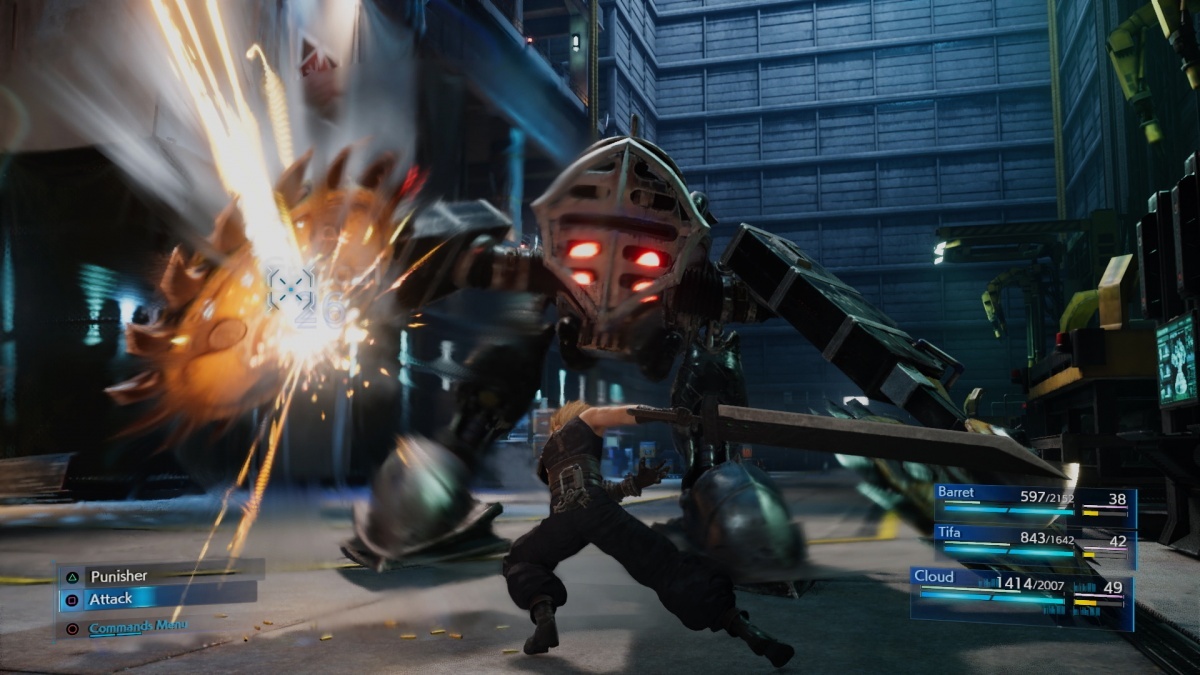
The sheer amount of customisation of the core combat allows is in keeping with the spirit of the original FFVII. Materia was always one of the franchise's best tools for customising a party, and that actually remains true. All five Materia types end up returning, more or less with their same functions. Magic Materia are green and gives access to the series' standard Spells; Support Materia are blue and is used to augment other Materia; Command Materia are yellow and lets characters use commands in battle, abilities which don't use MP; Complete Materia are purple and prioritizes buffing party members and the ATB; and, finally, Summon Materia are red, triggered only in certain instances during battle.
With a set party of three at all times (that players can't edit even when they have their full party of four,) and quite a bit of Materia to experiment with, not two parties will look alike. Beyond how much room there is for basic customisation, which weapons players have equipped and which characters they have in their party can result in wildly different Materia sets. In fact, even different boss fights can encourage players to jump back into their Materia and refine what they have equipped. Even better than the already exceptional core combat, Final Fantasy VII Remake has one of the best difficulty curves in a triple-A title in recent memory. This is by no means an easy play-through. Anyone looking to liberate Midgar from Shinra best be ready for a battle system that requires an actual understanding of not only the core mechanics, nuances of character switching.
By pressing left and right in battle, players can swap characters in an instant. This is rather important as enemies actually aggro exclusively to the character players are controlling. Party members can still be targeted, but there's a reason the AI mostly just blocks. The point of the combat loop really is to juggle the three party members, making use of every character's skill set in every battle. If players aren't switching between their party members, it's easy to quickly get swarmed during the harder fights. Bosses can be relentless, requiring players to understand how to Stagger and when to use Spells. It isn't enough to throw the strongest tiered Spell at a boss and hope for the best. In an attempt to balance magic, spell casting gets slower the stronger the spell. Thunder zaps out fast enough, but players need to be sure to keep a distance if they want to reliably pull off Thundagas. While party members can't be staggered, they can be knocked out of their spellcasting animation after already expending MP. It's important to consider where everyone is in relation to each other on the battlefield, especially since the command menu can be used to give party members commands mid-battle without needing to switch characters - although it's still encouraged.
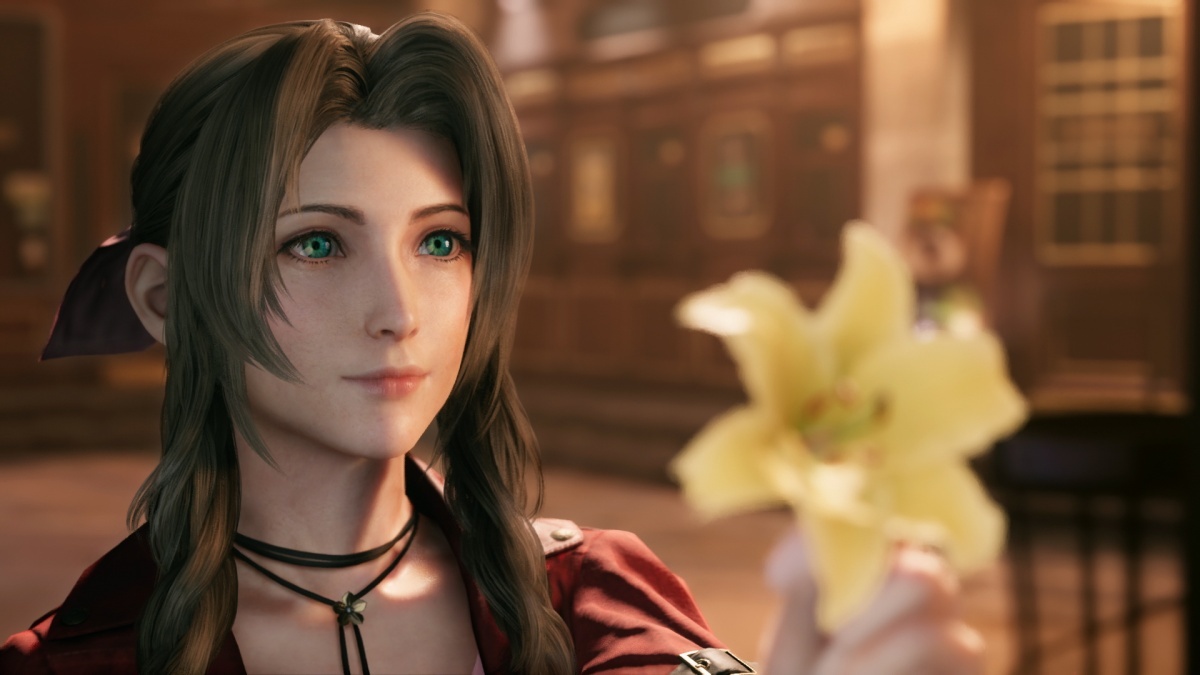
Even knowing to switch characters, give commands, use personal abilities, and conserve MP for when it is really needed, Final Fantasy VII Remake is still mechanically demanding in the best of ways. The fight against Reno and Rude stands out as a real highlight, and all the arena battles in Corneo's Colosseum are worth revisiting time and time again just to fully understand how each character plays. The penultimate chapter even introduces a fairly difficult set of VR battles to challenge the party at the last minute. VR battles not only make for a nice way to prepare for the grand finale, they're an opportunity to dive into Battle Intel - the remake's pseudo-achievement system. By completing combat specific challenges, Cloud can purchase brand new Materia from Chadley, a Shinra intern turned rogue, who offers his own set of VR battles which unlock new Summoning Materia in the process. As far as pure combat goes, FFVIIR is pure brilliance from top to bottom.
But games are more than their combat, and strong action unfortunately isn't enough to carry a remake of an RPG that was strong all around. When it comes down to it, nothing else in the remake manages to match the quality found in the battle system. There are moments of genius peppered throughout - Wall Market and Chapter 9 as a whole really are the highlight of the experience - but poor level design elsewhere makes it hard to enjoy the combat. If nothing else, the last few chapters throw waves of enemies at the player, making it easy to forget Cloud and company are mainly running through hallways. Even then, the poor level design could perhaps be forgiven if the story managed to stick the landing. The story is still gripping in spite of poor pacing, in spite of the Whispers, and in spite of Sephiroth's early presence. What attempts there are to alter the main narrative are for the most part harmless, and tend to come and go fast. There's even a large chunk of time in the second act where the Whispers and Sephiroth are completely gone, allowing the story to move along more or less naturally - expanding familiar beats meaningfully without the meta-commentary.
Unfortunately, the last act throws away almost 30 hours of build up to a confrontation with Shinra to focus primarily on Sephiroth, the Whispers, and the change of fate. When it comes down to it, this story is not a remake. Not truly. Without giving too much away, Final Fantasy VII Remake operates on the assumption that the audience is familiar with the 1997 original, and ends with an assertion that the journey to come will most certainly stray from the path of a remake. Worse yet, the ending - for whatever reason - goes out of its way to reverse a series of rather important deaths in the context of the story. Deaths, mind you, that fundamentally shaped character arcs and themes present in the original. For an action RPG that takes a mature look at fascism, eco-terrorism, and class struggles, FFVIIR is toothless when it comes to killing its main cast - something that gave, and still gives, the original quite a bit of legitimacy as a narrative.
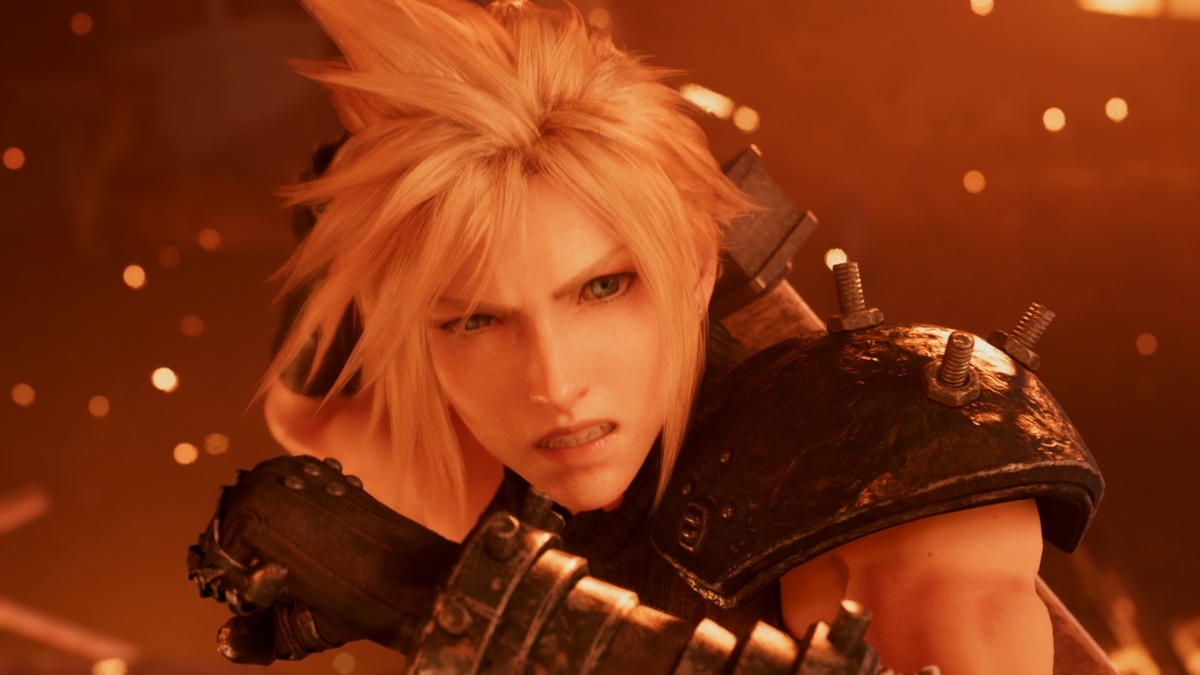
There's still a chance a sequel will more or less keep things on course, but it's basically impossible for this remake to proceed as an actual remake. The story is far too self-aware of the original game as a separate narrative at this point, and Part 2 is going to need to deal with some serious consequences from Part 1's jarring conclusion. It's painfully clear Square Enix didn't want to craft solely a remake. A pity, because those remade bits are leagues better than anything new the remake adds to the narrative. As if to rub salt into the wounds, the last few chapters do set up a satisfying conclusion. Shinra HQ makes for a fantastic final dungeon, littered with boss after boss all the way to the top. It's filled with tense encounters, tense storytelling, and culminates in a rescue hours in the making. Part 1 almost exclusively centres itself around the conflict between Avalanche and Shinra, so it only makes sense to cap off this portion of the story with the raid on Shinra HQ. That does appear to be the case, only for the plot to be hijacked by Sephiroth, with none of the elegance of the original. Frankly, it doesn't even feel like the remake comes to an end. Nothing that actually mattered to the plot resolves in a satisfying manner. Once the final boss is over, it's as if the story just stops - the end of a season of television, not a video game.
The ending is especially frustrating because the story cuts off at the point where the main cast is finally starting to connect. There's great character writing present from start to finish, but the party of five that comes out of Shinra's HQ go on to share some fantastic moments that Part 1 of the remake unfortunately couldn't touch upon. In general, there wasn't much the remake could do in unifying the party. For the most part, the play-through sees Cloud juggling between Barret, Tifa, and Aerith, until the end of it all. It's really a testament to the script that there's as much inter-party chemistry as there is. As extremely disappointing as the story ends up being, it's hard not to appreciate the spectacle of it all. For the most part, Final Fantasy VII Remake is a beautiful looking game. There are some clear areas where Square Enix cut corners (the Midgar skybox is just embarrassing,) but the cut-scene direction and character animations are utterly phenomenal. The star of the show has to be the dynamic lighting, though. The way the light bounces off the Buster Sword is enough to make one forget Cloud isn't a real super soldier for just a second.
Musically, quite a lot of remixes of the same songs are used, but they're all well composed, insanely catchy, and perfect for the remake's tone. As far as presentation goes, Square Enix does a good job at prettying up the remake. It's just a shame so many liberties were taken with both the story and the level design. Complexity was traded for longevity, and meaningfully storytelling was traded for self-indulgent fan service. As a complete game, FFVIIR doesn't even come close to rivalling the original. It's a nice companion piece that helps flesh out Midgar, but this is not a worthy remake. It's a decent sequel, though, and one with a lot of replay value. Upon clearing the final chapter, a Chapter Select is unlocked which allows players to tackle New Game Plus, in whatever order they choose.
Even better, Chapter Select comes with Hard Mode, and Square Enix has really outdone itself this time around. While the difficulty curve was already strong, the remake's Hard Mode ups the ante considerably. Not only are items completely restricted, and benches (which fully heal HP & MP on Normal) only heal HP, forcing players to consolidate their MP and wisely use their party's abilities. As the level cap is 50, and most parties will likely finish Normal mode nearing 40, the back half of Hard Mode demands mechanical mastery. Hard makes for a fitting final challenge, and an excellent showcase of the combat's depth. An ending that falls flat on its face makes it difficult to anticipate the inevitable Part 2, but outstanding combat and the chance to immerse oneself in Midgar do make the most anticipated remake of all time worth playing. Still, Square Enix dropping the ball both in regards to level design and storytelling outright ensure it will be fighting an uphill battle to "remake" the rest of the game from here on out. Final Fantasy VII Remake may be a relative disappointment, but it's still a strong action-RPG in its own right.
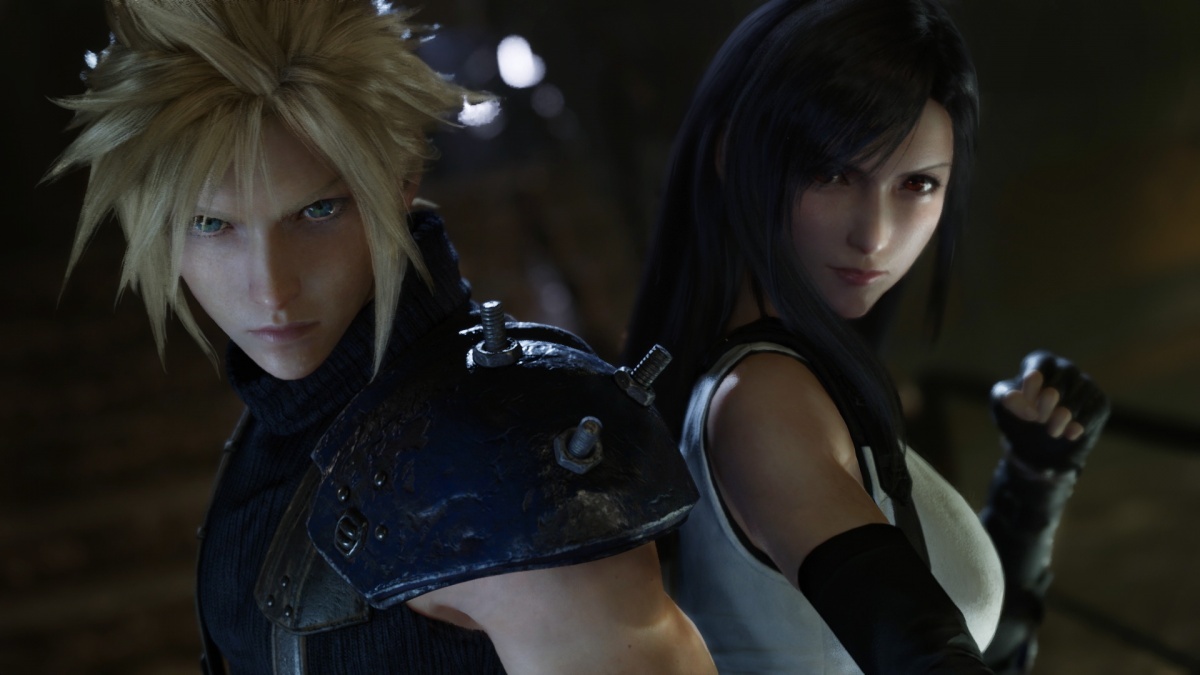
Cubed3 Rating
Very Good - Bronze Award

Mediocre world design, poor pacing, and plotting that fails to fully capture what made the original so special, it's hard not to walk away feeling like this isn't a disappointment across the board. At the same time, the franchise's combat has never been better, and Materia offers an incredibly rewarding amount of party customisation alongside weapon levelling. While the story on a whole might not hit all the right notes, the script is extremely well written and the dialogue has never been better. More importantly, the depth present within the battle system pairs wonderfully with a challenging, but very fair difficulty curve, making for some truly spectacular boss fights. Final Fantasy VII Remake will never be held in the same esteem as Final Fantasy VII - and for good reason - but damn good combat will keep action fans coming back to this RPG for years to come.

![]() 7/10
7/10
![]() 9/10
(1 Votes)
9/10
(1 Votes)
 Out now
Out now  Out now
Out now  Out now
Out now  Out now
Out now Comments
Comments are currently disabled

 Sign In
Sign In Game Details
Game Details Subscribe to this topic
Subscribe to this topic Features
Features





 Top
Top

